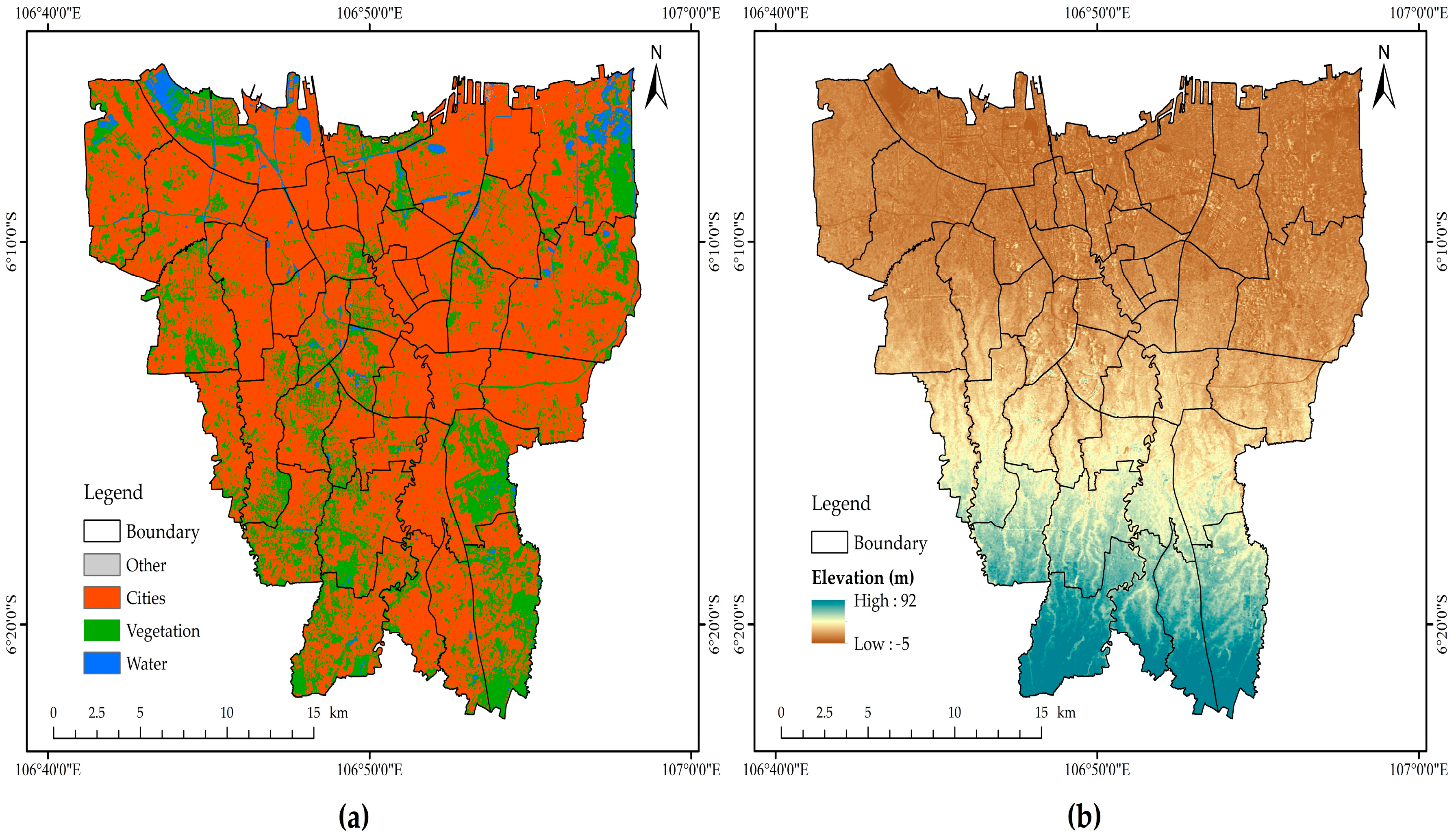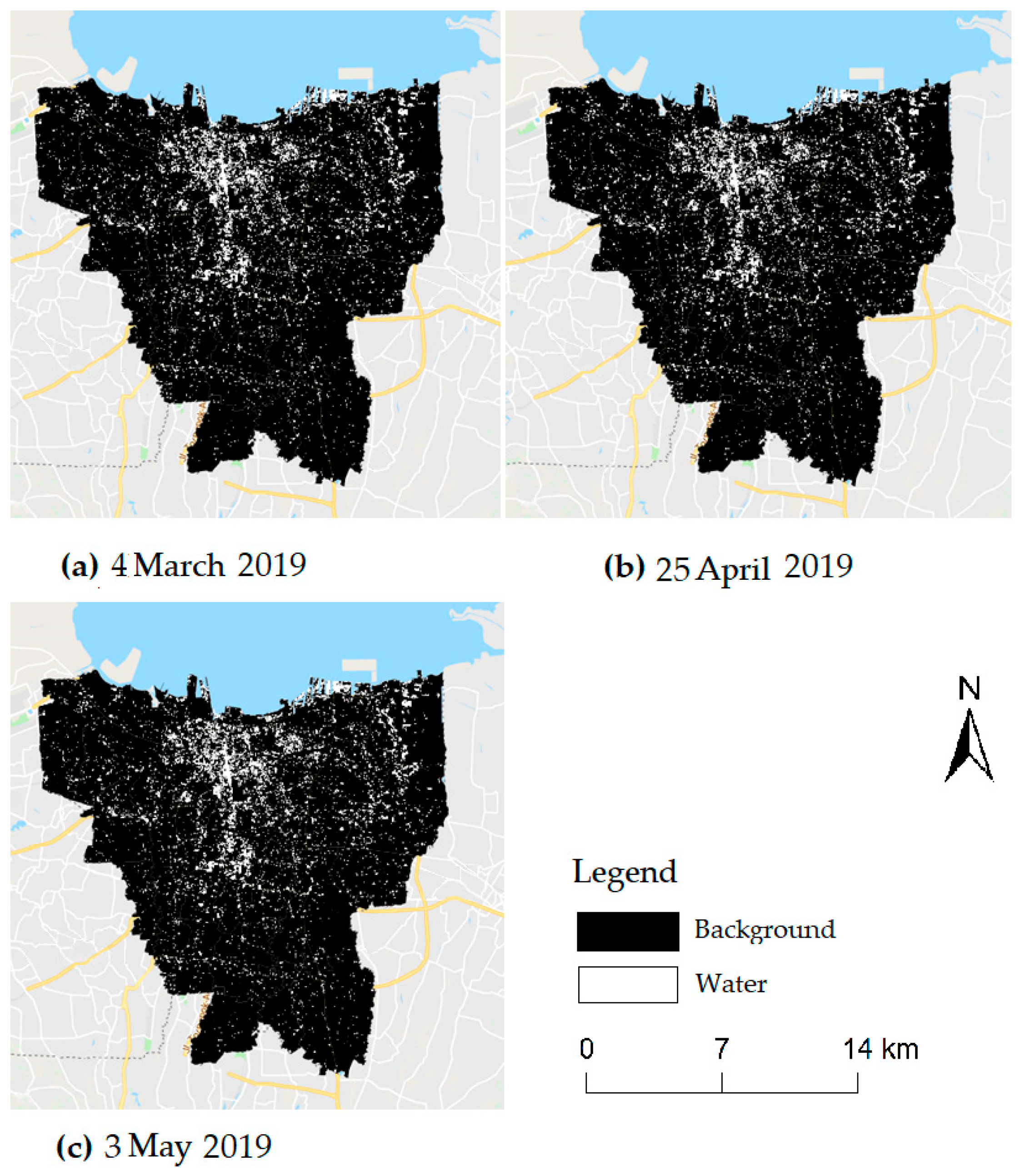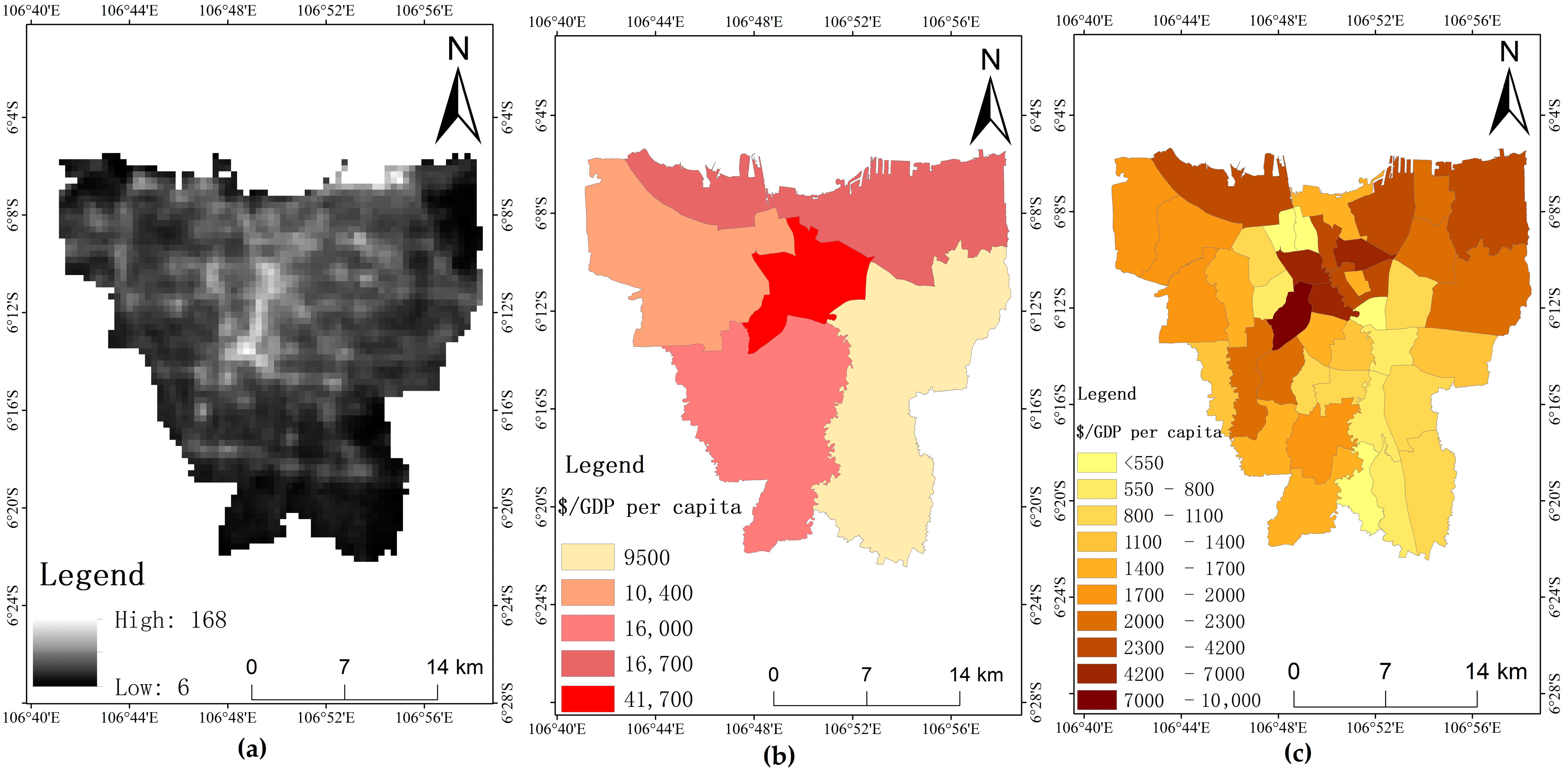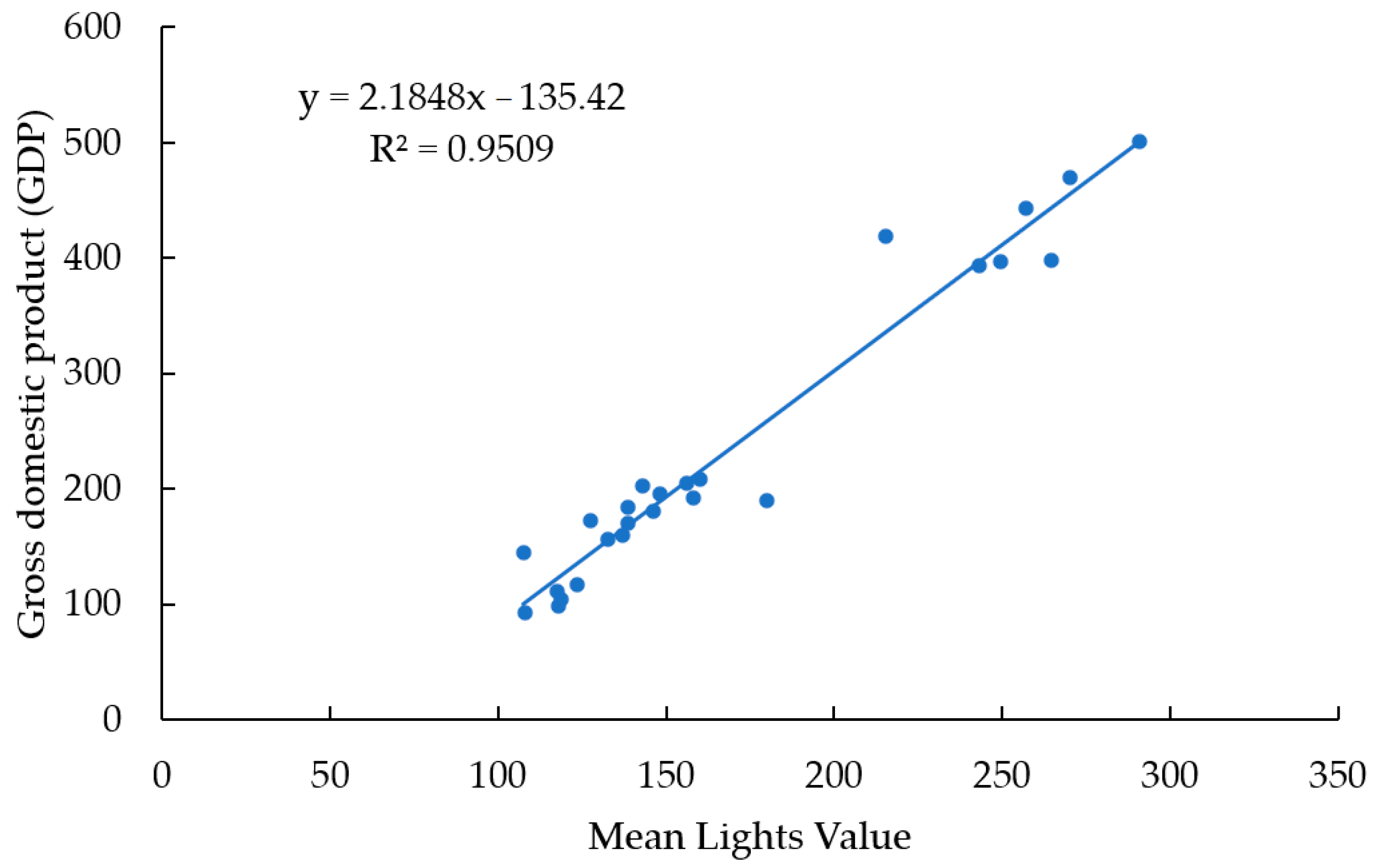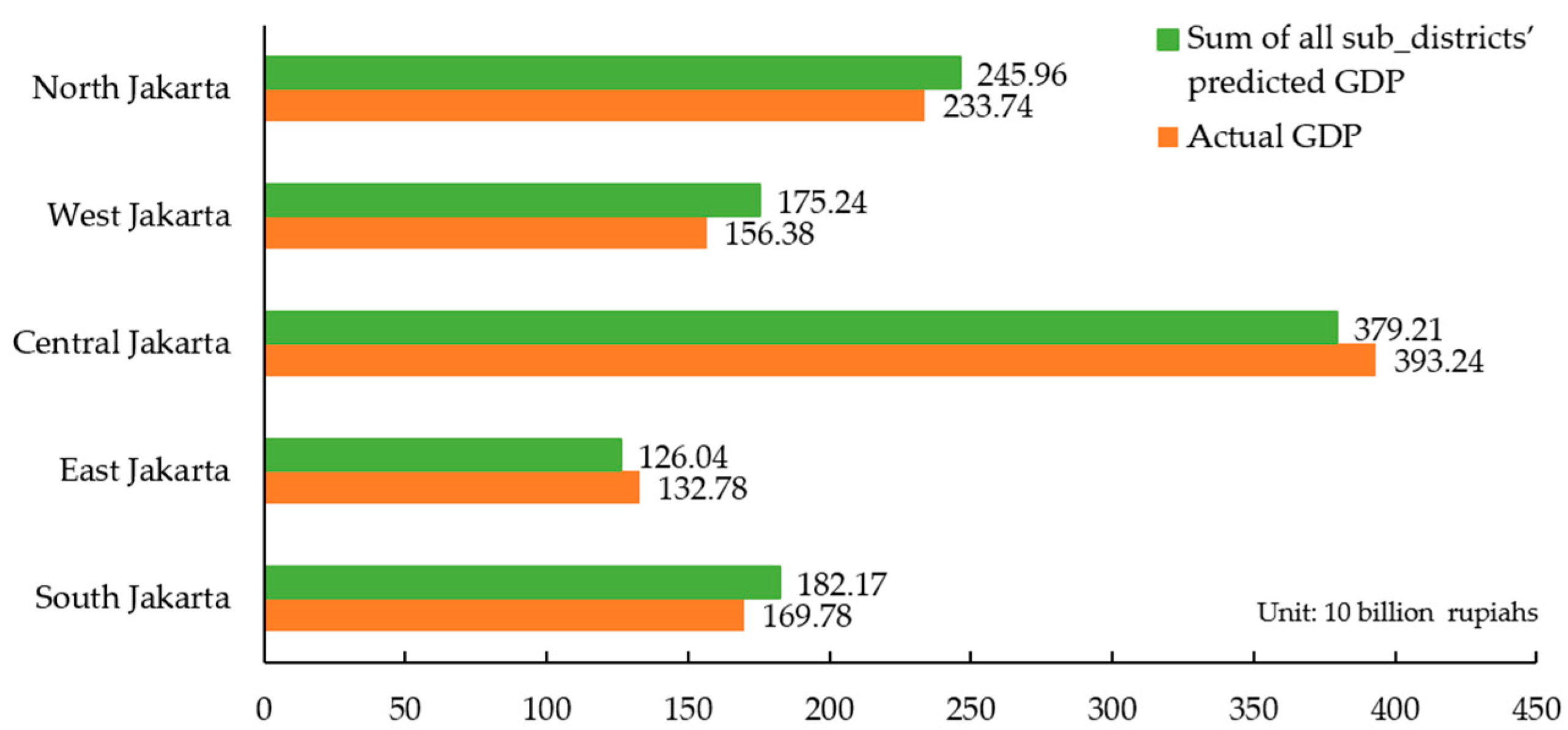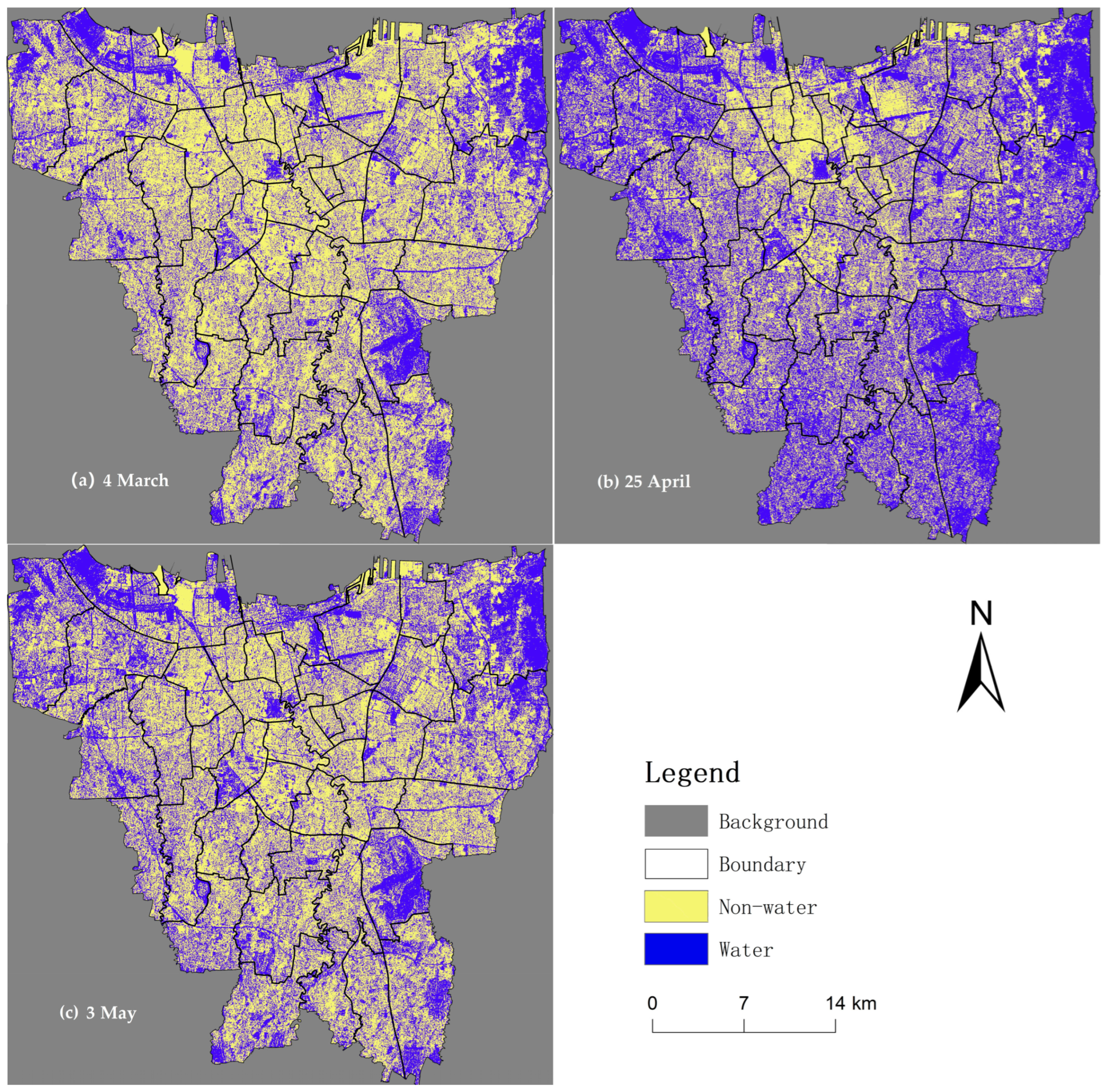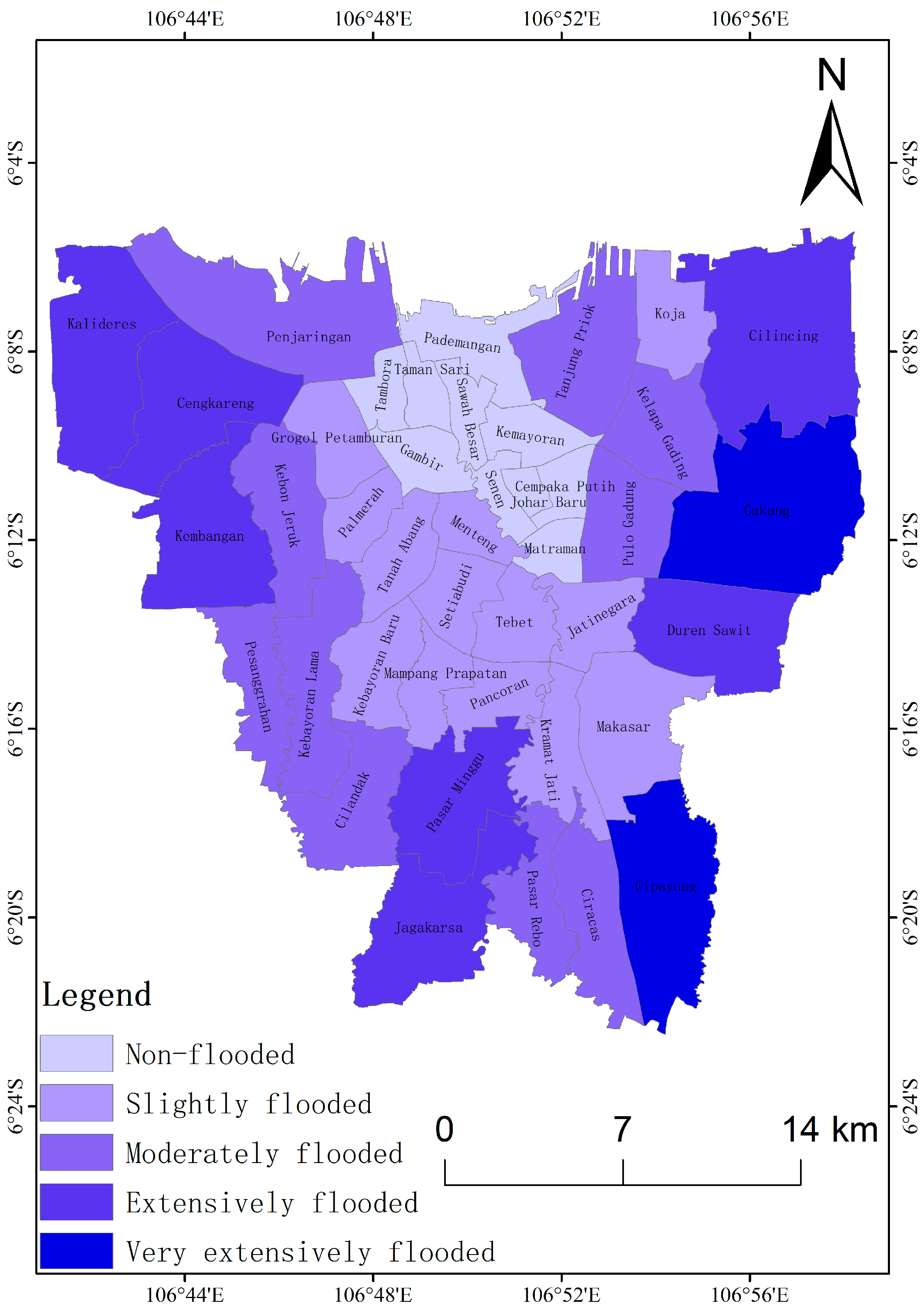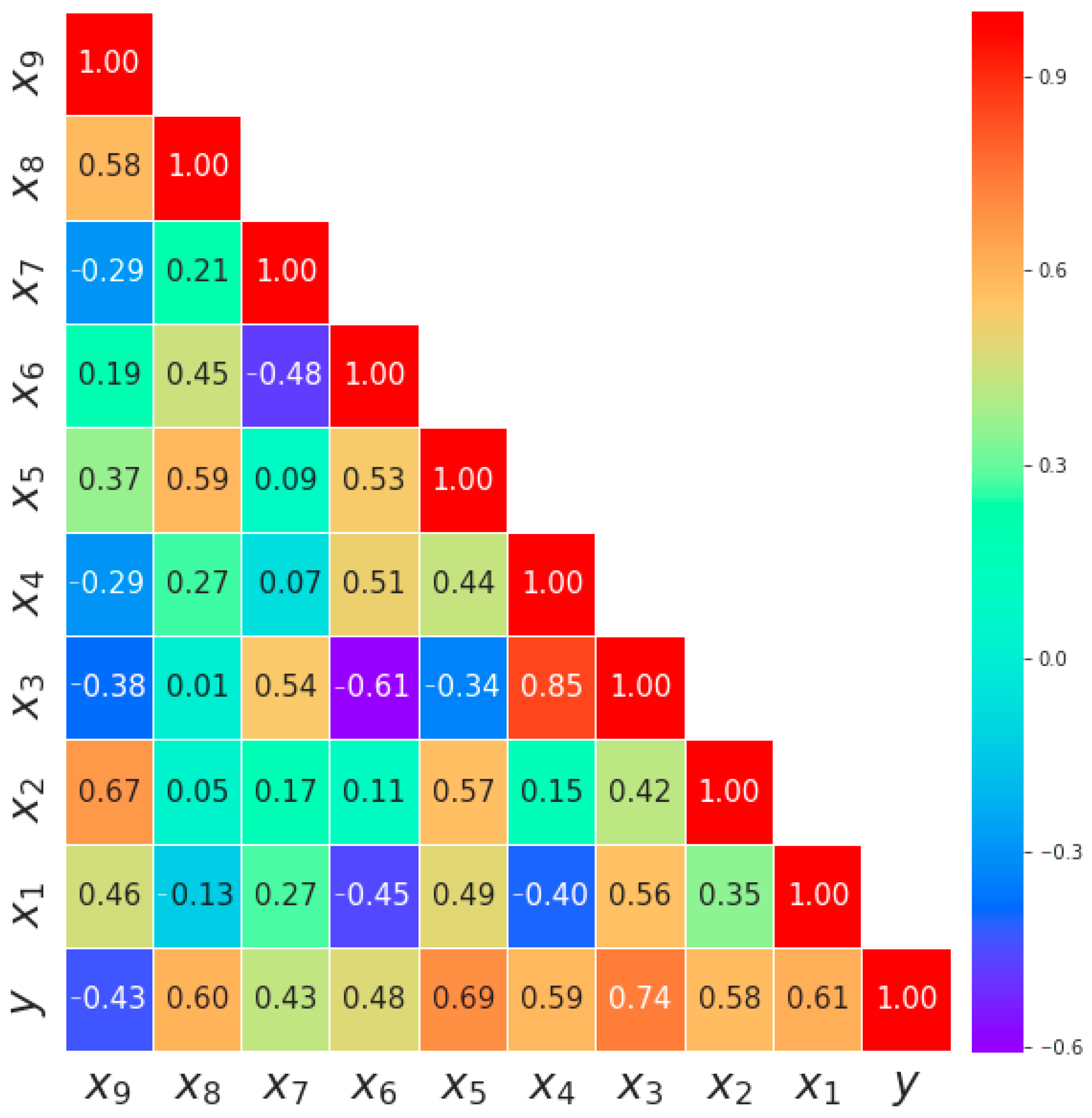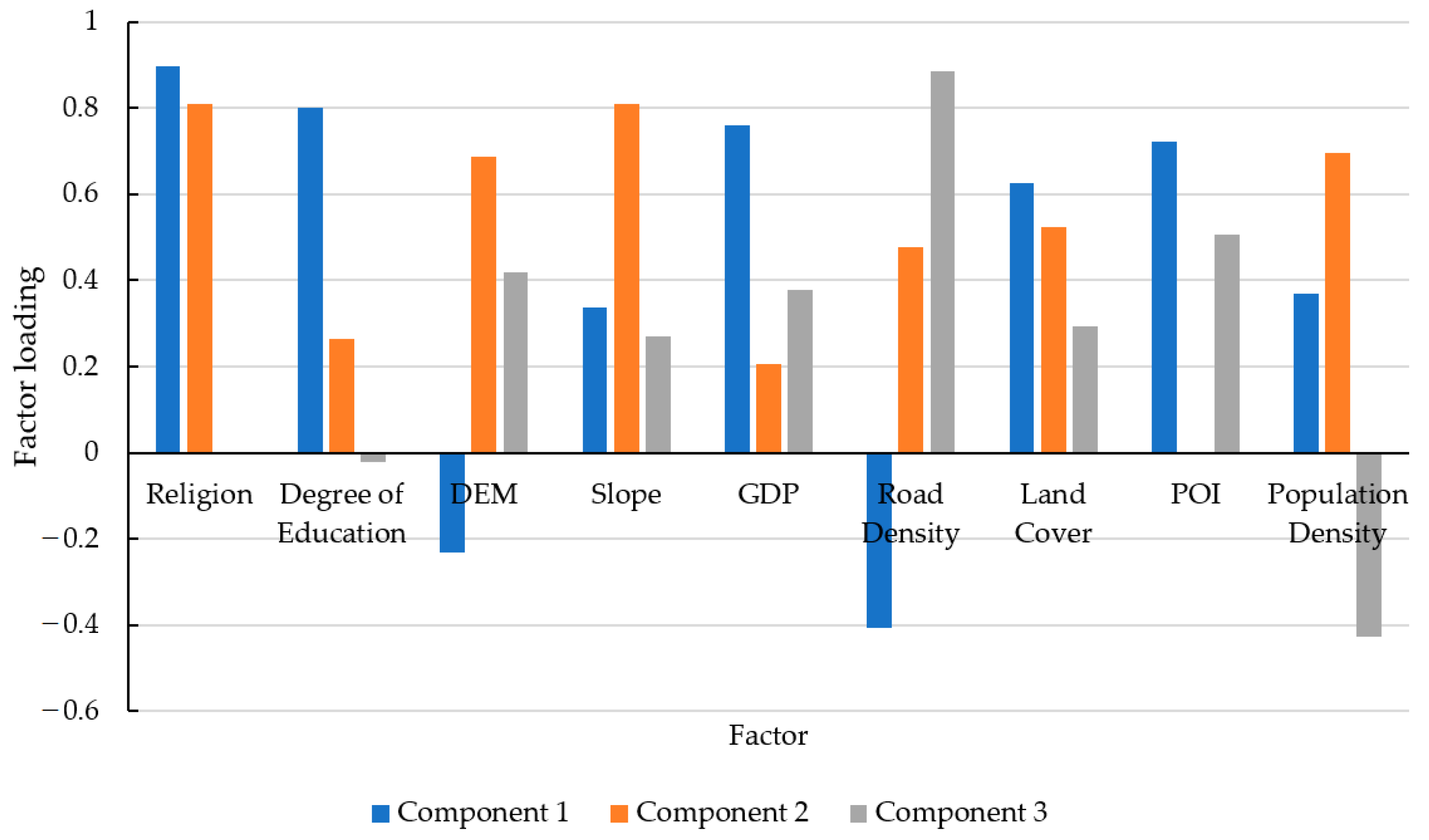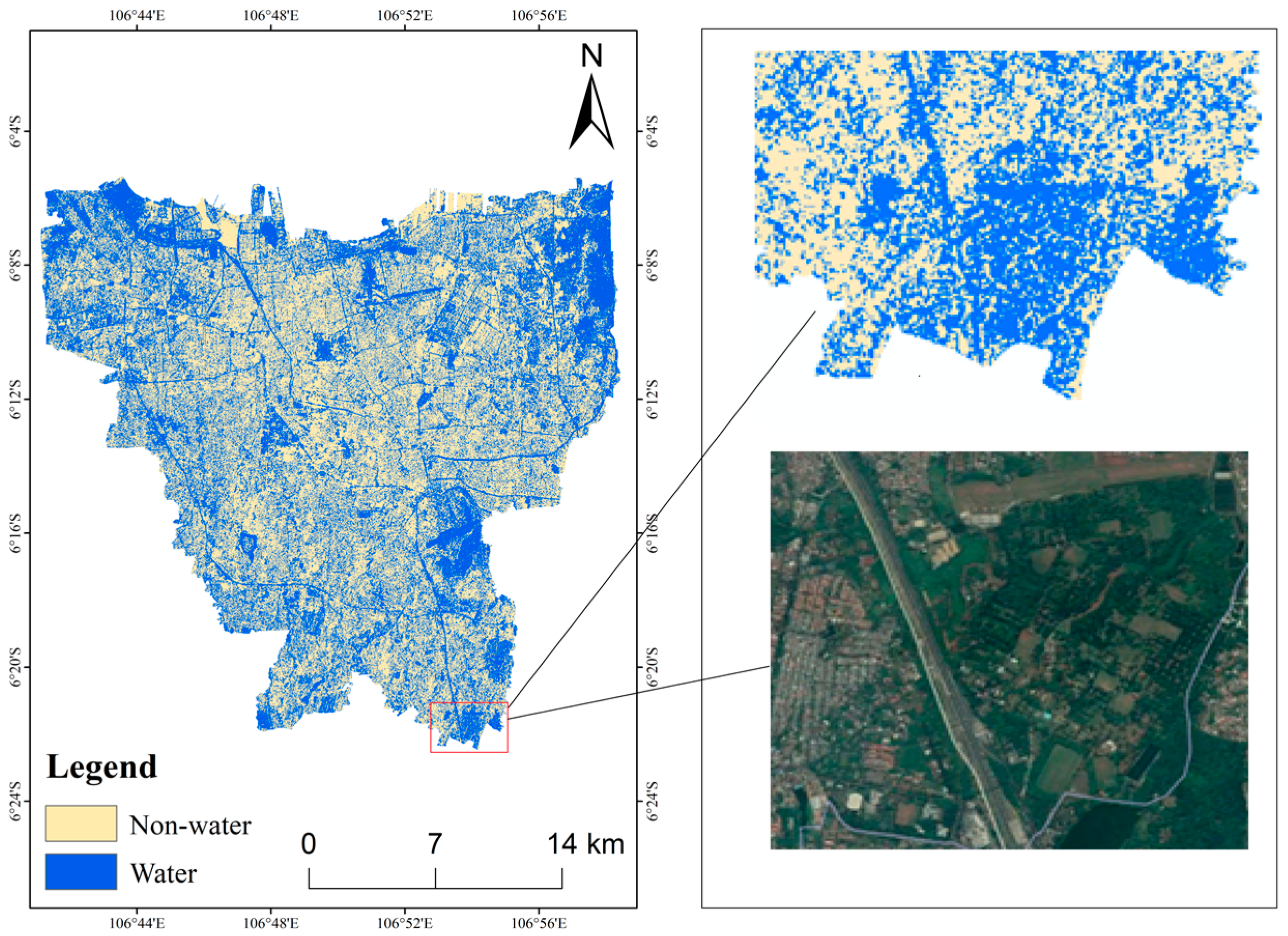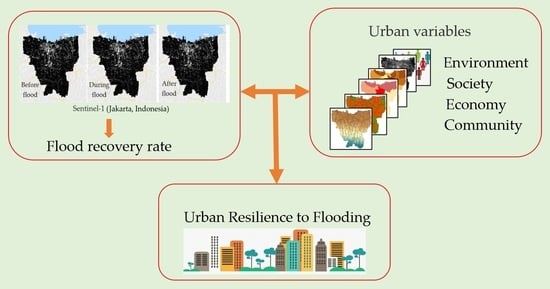1. Introduction
Climate change and continued urbanization have increased the vulnerability of cities to floods, especially for those along a coast and low-lying cities [
1,
2,
3]. The improvement of urban resilience to flooding, to reduce losses and accelerate post-disaster recovery, is a multifaceted challenge for policy makers [
4,
5]. Therefore, building a more resilient urban system against floods is of great significance not only for the safety of residents’ lives and property, but also for the sustainability of a city.
In order to address the urban flooding challenges, many approaches and projects have been conducted. Flood-control infrastructures (e.g., dams, canals, and embankments) are widely used in cities to effectively prevent urban floods, but these infrastructures cannot cope with extreme conditions that exceed their initial design capability. The damage caused by floods includes property losses, resident casualties, and the destruction of infrastructure, in addition to social instability and high recovery costs [
6,
7]. Thus, simply studying the causes, processes, and mechanisms of disasters and engineering defense measures in disaster management can no longer meet the needs of disaster prevention and reduction; the effects of disasters on human society must also be scrutinized. The discharge/emission of industrial wastewater and waste gas may be used to monitor the recovery of people’s lives and local industrial production during a post-disaster period, which reflects the recovery capability and resilience of a city [
8]. Therefore, attention has gradually been shifted from studying only hazard factors to examining the effect of the vulnerability of hazard-effected infrastructure on disaster formation [
9,
10]. As a corollary, the concept of resilience is used to assess the effect of urban flooding. Sponge city projects [
11], water-sensitive urban design, and low-impact development are also implemented to improve urban resilience.
In general, resilience can be defined as “the ability of an individual, community, city or nation to resist, absorb or recover from a shock (such as an extreme flood), and/or successfully adapt to adversity or a change in conditions (such as climate change or an economic downturn) in a timely and efficient manner” [
12]. As for urban resilience, urban infrastructure is closely related to urban resilience, and provides references for assessing urban resilience to natural disasters [
13,
14]. According to previous studies [
8,
15,
16], urban variables to represent factors to evaluate resilience, and can be divided the variables into the four dimensions of society, environment, community, and economy. The social dimension focuses on describing the demographic indicators, as these are a key component of society. Areas with a high population density have a higher disaster-defense capability than those with a low population density. In addition, the process of recovery from natural disasters is more rapid in areas with a large proportion of males. The religious factor is also taken into account in demographic indicators, as it is generally believed that the greater the concentration of people of the same religion in an area, the more united is the community, and thus the more rapid is the post-disaster reconstruction in the area than in less united areas [
17,
18]. The environmental dimension describes the effect of the natural environment and ecology on urban resilience. Climate and geographical factors are added to datasets to explore how to enhance urban resilience using geographic information systems (GIS) techniques [
19,
20]. Urban resilience is not only affected by the infrastructure and planning within a city, but also related to natural external factors (e.g., monsoon, mountains, and temperature) [
21]. For example, green space counters the deterioration of urban ecological conditions [
22], and lower elevation and slope improves road accessibility and rescue-work efficiency [
23,
24]. The community dimension aims to assess the resistance of communities before the flood disaster and their response capacity afterward. For example, the number of hospitals and shelters can be used to assess a community’s ability to deal with emergency events [
17,
25]. In addition, the higher the educational level of a community’s residents, the more scientifically and efficiently the community can deal with disaster events [
18]. The fourth dimension focuses on economic indicators. Areas with a high GDP per capita and a high POI density will have more financial resources for post-disaster reconstruction after floods than those with lower values of these indicators. Similarly, areas with a high road density have a stronger traffic capacity and more well-developed industries, which means post-disaster rescue operations are easier to perform in these areas than in less road-dense and industry-containing areas [
26,
27,
28]. In addition, space and structure environment are mainly considered in the context of disaster prevention, whereas the dimensions of society and risk management are the focus of post-disaster reconstruction.
The duration and scope of floods, in addition to the losses they cause, must be considered when examining urban resilience to floods [
29,
30]. Resilience frameworks were previously evaluated through infrastructure-recovery indicators, such as building reconstruction, restoration of public facilities, and productivity recovery [
13,
31]. Although such infrastructure-recovery indicators are widely used as an indirect reflection of urban resilience [
32], the period of flood submergence, namely the time and speed of flood recession, is also a critical aspect of resilience. Few studies have presented a complete urban-resilience evaluation system from the perspective of flood accumulation and release, though the scale and time of floods directly determines the level of infrastructure damage [
33,
34]. This is mainly due to the difficulty of obtaining relevant data to measure or calculate a continuous flood process, especially in developing countries and poor areas [
35]. This poses a challenge to establishing indicators that directly measure flood recovery.
The wide scanning range, low cost, real-time information acquisition, and periodic surface coverage of satellite remote-sensing technology has led to its acceptance as an efficient and appropriate means of extracting and monitoring the changes and areas of floods across various spatiotemporal scales [
36,
37]. In optical remote-sensing applications, National Oceanic and Atmospheric Administration/Advanced Very High Resolution Radiometer time-series data and Moderate Resolution Imaging Spectroradiometer (MODIS), Landsat, and GaoFen satellite data have been used to dynamically monitor water information [
38,
39,
40]. The continuous and strong absorption of water in the near-infrared and short-wave infrared regions in remote-sensing images has led to the development of different water-detection indexes, such as the normalized differential water index (NDWI) [
41], the modified normalized difference water index (MDNWI) [
42], the automated water extraction index (AWEI) [
6], and the water index (WI) [
43]. Although the spatial and temporal resolutions of optical remote-sensing images are constantly improving, their data quality is easily affected by climate conditions, especially clouds [
44]. Synthetic aperture radar (SAR) is a remote-sensing microwave sensor that is capable of continuous operation and is sensitive to water [
45,
46]. European Remote-Sensing Satellite-1 SAR images were used to distinguish flood information based on active contour models comprising grayscale and textural features, and the results showed that this method extracts flood boundaries with high accuracy [
47]. Wang, et al. [
48] used Sentinel-1A (S1A) data to extract the range of Ebinur Lake, Xinjiang, China, from February 2017 to February 2018 with an accuracy of 99.4%. Moreover, a new water index based on Sentinel-1 data was also used to dynamically monitor changes in water area [
49].
The aim of this study was to examine how to improve the resilience of cities by combining remote-sensing technology with factors from different resilience domains. We attempted to evaluate and analyze urban resilience via a case study of Jakarta, Indonesia, where floods are common in summer. Thus, we used the Otsu model and remote-sensing data to calculate the flood area of 42 different subdistricts in Jakarta on 25 April and 3 May 2019, respectively to compare the speed of flood recession from each of these subdistricts. We also collected the data of factors related to floods in each subdistrict of Jakarta, and used principal component analysis (PCA) to quantify the relative importance of these factors, and their correlations with the speed of flood recession.
5. Conclusions
This study used remote-sensing data combined with multiple dimensions of urban factors to calculate and analyze the differences and causes of urban resilience in different regions. The S1A data on three dates were used to extract the flooded area, and the changes in these areas, using the Otsu method. In addition, urban basic data such as the POI, GDP, and DEM were used to analyze the correlation between the flooded area and the recovery rate (Sig. < 0.05). Irrelevant data were then removed and the remaining data were used as factors for urban resilience. Finally, PCA was employed to reduce the dimensionality of high-dimensional factors, and the original nine factors were replaced by three principal components (total explanation > 90%). The weight coefficient of each factor was calculated by the characteristic root, variance contribution of the principal components, and the loading matrix of the original factor.
Remote sensing overcomes the problem of obtaining large-scale flood boundaries, especially for areas without meteorological and hydrological stations, which improves the accuracy of flood-flow calculations and provides a more accurate basis for disaster reduction and preventing floods. In addition, the data we used in this study can be provided to support flooding projects, such as sponge city, water-sensitive urban design, low-impact development. Moreover, this method provides a new direction for the selection of indicators for the evaluation of resilience frameworks, and to guide urban responses to natural disasters.
The limitations of experimental conditions indicate that there is still room for improvement of study. For example, new indicators could be added to improve the correlations between various factors and flood-recovery rates, such as climate factors that are directly related to the occurrence of floods (real-time precipitation, precipitation time, etc.) and factors related to community-street flood drainage (length of urban underground water pipes, number of sewer covers, length of the dike, urban communication coverage, etc.). Furthermore, this study mainly measured regional resilience from the perspective of urban post-disaster recovery, but urban vulnerability and property loss (i.e., the number of buildings damaged and number of casualties) may also be used as dimensions to measure urban resilience. Subsequent studies will attempt to add these data (if available) to the urban infrastructure database, and examine their contributions to urban resilience.

